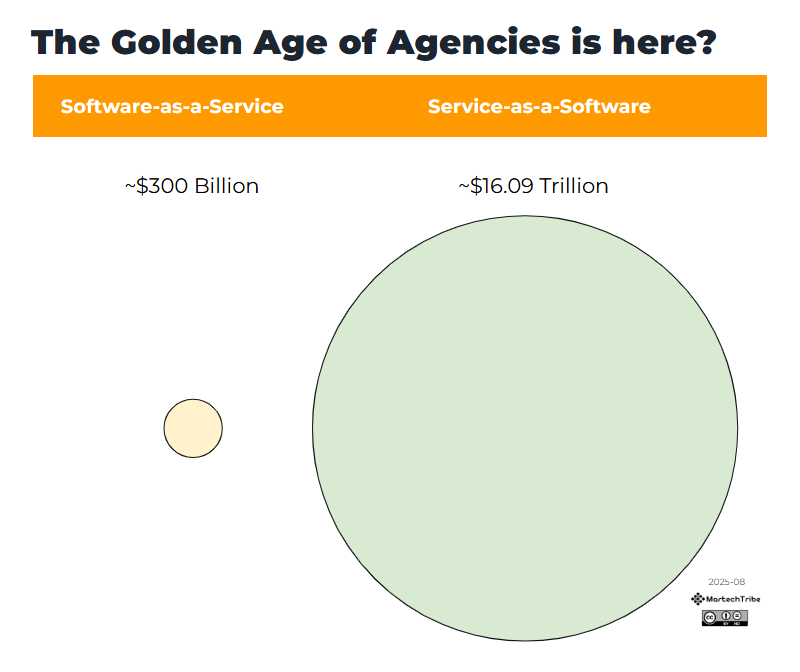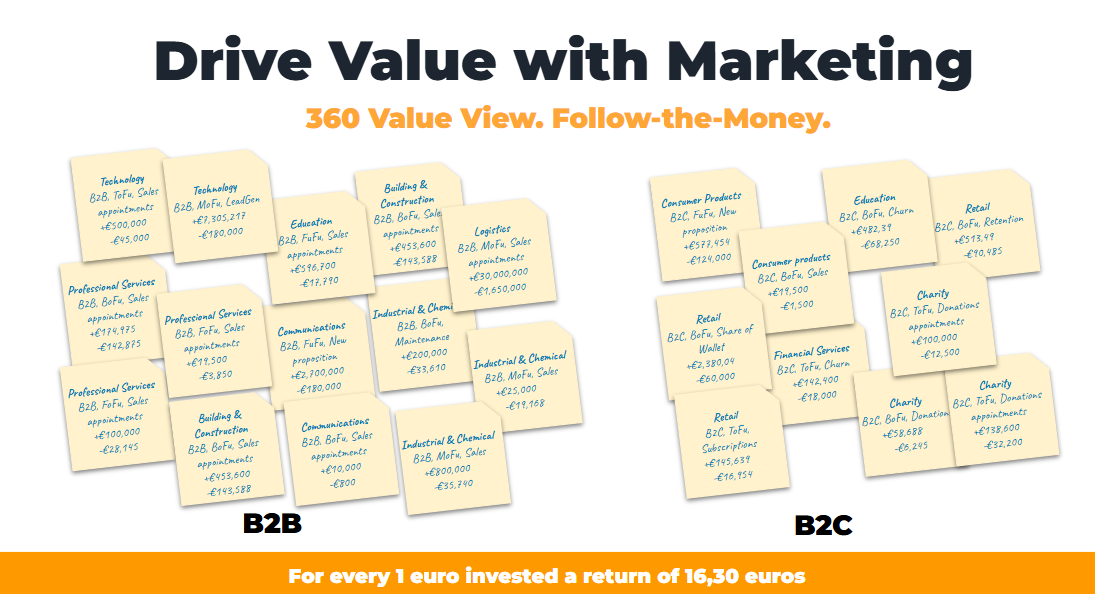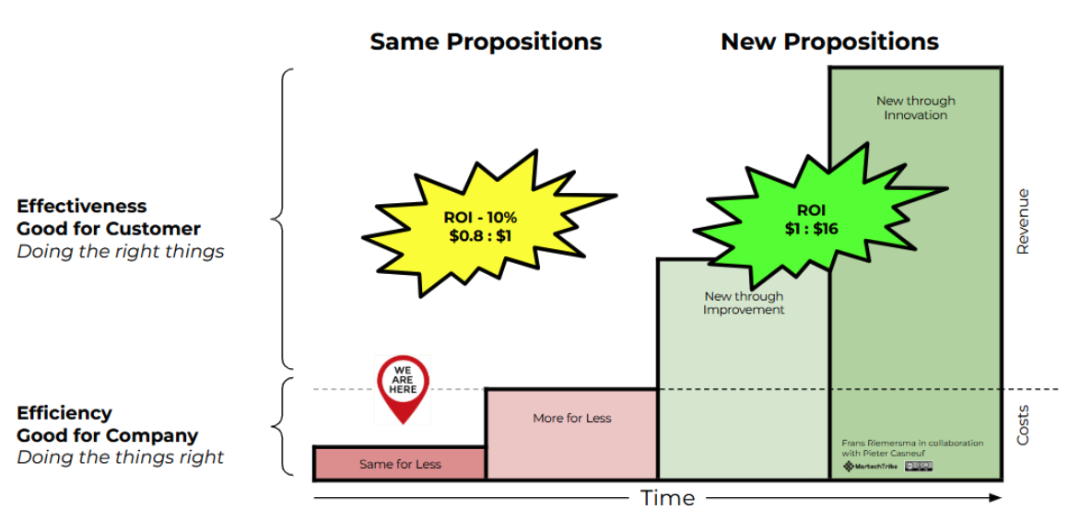
1,751 Content & Experience martech tools can easily overwhelm marketers. By analyzing 200+ real-life marketing technology stacks, we discovered that marketers first invest in CMS & Web Presence, followed by lead capturing tools, Search Engine tools, and finally Content Optimization tools.
This blog post on Content & Experience tools is part of a series. Other categories in the Martech Supergraphic are discussed in detail here:
- Ads & Promotions
- Content & Experience - you found it!
- Social & Relationships
- Commerce & Sales
- Data
- Management

6 Content & Experience ‘Jobs to be done’ are Key to Marketing Success
The Content & Experience category of the Supergraphic is about creating owned content that resonates with a target audience. Marketers are trying to get (organic) visitors intrigued by their product, and thirsty for more information. The subcategory names of the Martech Supergraphic describe marketing tasks, processes or ‘Jobs to be done’. They can be a starting point for learning to navigate the Supergraphic.

The individual tool names of the Martech Supergraphic can tell us what tools are dominant, and which of their capabilities are vital for running marketing activities.

As you can read in our previous article, marketers first get to grips with Ads & Promotion tools to generate website traffic. By exposing visitors to owned content on their website, marketers ultimately try to generate Marketing Qualified Leads (MQLs), ready to be handed over to the sales process. We’ll dig into Social & Relationships, and Commerce & Sales tools in upcoming blog posts.
Now let’s zoom in on the most popular subcategories in the Content & Experience Supergraphic category.
1. CMS & Web Experience Management
Introduction
When it comes to Content & Experience tools, marketers first invest in owned content on their website. They secure their web presence by using CMS & Web Experience Management tools.
CMS stands for Content Management System. A CMS enables a company to collaboratively design, manage and publish a website. Most CMSs nowadays are Web-based. The idea of a a CMS is Create Once Publish Everywhere (COPE). By separating content from layout, maintenance becomes easier. It helps marketers to publish a consistent message and streamline their publication across all channels. Some CMS tools are free, or open source. Many CMSs integrate with other existing marketing technologies or webshop related tools.
Once the word is out on (social) media, the interested audience will want to learn more about a brand, product or service on the company website. As CMS hosts owned content, it is the most popular Content & Experience subcategory.
Marketers mainly use Wordpress. Adobe Experience Manager is mentioned just outside the top 20 tools in this category, and is therefore not shown in the bar chart above. We expect a higher positioning as soon as more enterprise companies submit their stacks to the benchmark survey.
In addition to content and web pages, a CMS also stores Digital Assets such as logos, photography, etc. Also Drupal and Typo3 rank just outside the top 20. The absence of popular CMS tools like Wix and Joomla might have to do with the stack population.
Adobe Creative Cloud consists of a set of applications for graphic design, photography & video editing and web development, such as Adobe Photoshop, Adobe Illustrator, Adobe Premiere Pro and Adobe Acrobat.
SlideShare is owned by LinkedIn. It allows marketers to publish products & branded slide decks. To us, Slideshare feels more like a social media tool belonging to Ads & Promotions.
Also, we could make the case that a fundamental subcategory is entirely missing in the Supergraphic, namely Product information System (PIM). PIM is a hub between ERP and Marketing & Sales. It stores the core product data and content and feeds into CMS tools, especially in larger companies as well as webshops.
2. Marketing Automation & Campaign/Lead Management
Introduction
With traffic frequenting their website, it is time for marketers to capture & nurture leads with Marketing Automation & Campaign/Lead Management tools. This yields insights into which themes, topics and keywords trigger certain segments of their target audience.
With decent web traffic, marketers now want to figure out who the visitors are and what they are interested in. This is where Marketing Automation comes inis. Marketing Automation was originally focused on email marketing automation, capturing email addresses through seducing webform offers.
Today marketing automation refers to a broader range of automation tooling for marketing. It helps to generate and nurture leads with complex omni-channel marketing campaigns, as well as segmentation, lead scoring and analysis, The end goal is to cross-sell and upsell, fuel retention and deliver sound Marketing ROI measurement. The ultimate goal for marketing is to convert them from anonymous into known individuals. Once known, marketers can start to engage and talk with them as leads.
Integration is key here too. Marketing Automation tools usually follow the Visitor to Lead flow. A part they facilitate themselves, such as Call to Actions (CTA), Pop-Ups, Landing Pages, Blogs, Microsites, Form, ect…. Additionally it needs to interface with CMS / Customer Experience / Front-end applications, as well as ERP for tapping into the sales history, CRM for consolidated customer data and PIM for product information as well as products matching customer's needs to serve relevant content.
These activities are supported by Marketing Automation tools such as Marketo, Hubspot, Eloqua (acquired by Oracle) and Salesforce Pardot. The tools enable marketers to do social posts, create webforms, microsites and landing pages with the aim of capturing email addresses. Automated or drip campaigns do the rest. These tools help marketers to talk to their customers by sending them relevant content and emails. Ideally leads convert into Marketing Qualified Leads (MQLs), or even better, Sales Qualified Leads (SQLs).
MailChimp is an email marketing tool. It allows marketers to create webforms, maintain lists of generated leads and nurture them via emails. It started to add some marketing automation capabilities to their core features.
3. Search Engine Optimization (SEO)
Introduction
When marketers have had their first success approaching contacts with automation initiatives, it’s time to make it easier for people to find them on search engines. To grow web traffic, Search Engine Optimization (SEO) is the next step.
SEO intends to increase the ranking of websites in the results pages of search engines like Google, Bing, Yahoo and DuckDuckGo. SEO excludes paid placements. Paid placements in search engine are part of Search Engine Advertising (SEA), which is part of Ads & Promotions.
Optimizing search engine ranking is concerned with tactics like meta tagging, the use of specific keywords, generation of backlinks, the adaptation of content on a webpage as well as the structure can make a huge difference in search engine rankings.
With the owned content in place and getting to grips with engagements, marketers aim to increase web traffic. It is interesting to see that mainly two tools make SEO a popular subcategory.
Moz offers a range of SEO tools such as keyword research, link building, site audits and page optimization. Optimizing search results can work even better if you outsmart the competition. That is where SEMrush comes into play. It explores how well your brand is doing on search engines, compared to the competition. SEMrush also offers tooling for Paid Traffic, Social Media, Content & PR.
4. Video Marketing
Introduction
Video Marketing as well as Content Marketing rank equally high in our graphs. Both subcategories have the intention to create visual content, because a (moving) picture says more than a thousand words.
To increase engagement levels, marketers use Video Marketing. Video marketing is broader than the video advertising we discussed in our previous blog post. It supports the creation, management, optimization and analysis of owned videos, covering the company or its products.
Many marketers know that visitors (and Google’s algorithm especially) appreciate videos as webcontent. Wistia, Vidyard and Vimeo are platforms that allow marketers to publish their videos, as well as to host video embedded on their own website. These tools also integrate with other tools. Vimeo integrates with editing tools such as Adobe Premiere Pro, Final Cut Pro, and Dropbox. Vidyard and Wistia integrate with plenty of CRM and marketing automation tools. Vidyard takes it one level higher and offers personalized video creation synced with CRM platforms.
You might miss Youtube in this list. So do we. In the Supergraphic Youtube is categorized as Video Advertising. We believe a larger part of what YouTube delivers to marketers is Video Marketing.
A different category of tools for video creation and marketing (e.g. Brightcove, Screencastomatic, Camtasia or Vimeo Pro) are surfacing just outside the top 20 tools we considered in our graphs.
5. Content Marketing
Introduction
Content Marketing tools are used to create and manage (branded) visuals. Equally important as moving pictures, marketing teams need to create the visual aspects of owned content, such as websites, e-books, white papers, product sheets and slide decks.
Adobe Illustrator is a graphics editor most marketers and creatives know and use. Canva is the easy-to-use, quick-to-start version of Adobe Illustrator, which also makes it easy to collaborate on visual content.
With the (moving) pictures in place, content marketing tools help to integrate and distribute personalized content across multiple channels. Uberflip enables marketers to personalize content at scale, with content for every stage of the buyer journey, such as blog articles, social media, videos or eBooks into a responsive interface with Call to Action’s (CTA). Content marketing tools also help with Demand Generation, Account-Based Marketing, Sales Enablement and Content Marketing.
A logical next step would to go into the area of Interactive Content with tools like Ceros and Snapapp.
6. Optimization, Personalization & Testing
Introduction
Once you have your (moving) pictures sorted, it is time to take your martech capacity to the next level. Now is the time for marketers to start testing & optimizing content with Optimization, Personalization & Testing tools.
A more advanced function of Content and Experience tools is to understand visitor behavior in more detail, using web optimization tools. Getting to know customers will help to, for instance, find a CTA that converts visitors into leads (from anonymous to known).
Optimizely is a conversion rate optimization platform. In addition to A/B testing Optimizely also enables personalization, data-driven decision and serving online advertising. It supports the building of hypothesis based experiments to optimize the experience for the end users, perpetually.
Unbounce helps marketers find the best landing page for reducing turnaround time and converting more traffic. Apart from social share counts, Buzzsumo helps to understand what your potential audience is speaking about and sharing. This helps to optimize content to outperform the competition and generate awareness in the industry. You might even want to reach out to influencers to promote your content.
How to walk the six stages of Content & Experience ‘Jobs to be done
To summarize…
- Host owned content with CMS & Web Experience Management (1)
- Get to know and engage with visitors using Marketing Automation & Campaign/Lead Management (2)
- Increase rankings and web traffic with Search Engine Optimization (SEO) (3)
- Boost engagement with Video Marketing (4)
- Collaborate while creating personalized, visual content with Content Marketing (5)
- Perpetually optimize by building true hypothesis based experiments to create irresistible CTAs with Optimization, Personalization & Testing (6).
So, that is it for this Supergraphic category. If you are ready to get to grips with the next category, Social & Relationships, stay tuned!

If you want to contribute to the ongoing Martech Benchmark research, submit your stack now. You’ll receive an automatically generated, personalized report in minutes.If you’re really getting the hang of it, email Frans to talk about a MarTech training from MartechAcademy.
Thanks to…
Lastly, a huge thank you to our magnificent and ever-growing review panel. Annika Werner, Carlos Doughty, Carmine Basil, Danielle Balestra, Doug Kessler, Hans van der Meulen, Huib Stad, Iban Rios, Julia Valentine, Kirsten Wildberger, Maarten Rijswijk, Marinka Eekman, Mark Wakelin, Matthieu Vermeulen, Mayer Becker, Mayur Soni, Michael Sweeney, Moni Oloyede, Nikki Kyriakopoulos, Odd Morten Sørensen, Peter Krmpotic, Peter Meijers, Rene Steiner, Roel Seegers, Samuel Schmitt, Scott Sweeney, Simon Daniels, Sree Vattikuti, Stacy Falkman, Travis Martin, Venkatesha(Venky) Murthy.
About this research
The Marketing Technology Landscape contains 7,040 tools spread over 50 subcategories, which are represented in the Martech Supergraphic. This is simply too much to take in. If we are not careful, marketers might think the field of martech is too complicated altogether, and might not capitalize on its huge potential.
In six blog posts, we’ll try to discover which stages companies usually go through as they improve their stack. We’ll explore which tools other companies are using, so you can identify how your company’s stack compares – where it overlaps and where gaps are. If you are over-equipped in a specific area, you might be able to cut out some tools and accompanying costs. And if you are under-equipped, you have a great opportunity to improve your marketing efforts.
If you are interested in how the martech market has developed over the years, including the data category, read all about Martech consolidation here.
When reading through the research results, please bear in mind that the sample is leaning towards SME B2B technology companies with between 25 to 1000 staff members and an annual turnover of 10 to 50 million dollars.
Want to contribute to the ongoing Martech Benchmark research? Submit your stack now.
Important note: We see our stack population of 200 Martech stacks as a first indicator for which type of tools marketers use or need. We aim to distill a ‘Martech roadmap’ that outlines which tools marketers need to improve their Martech capability over time, as their company develops.
Please understand that our research population is mainly covering SME B2B technology companies with between 25-1,000 staff members and yearly turnover of 10-50 million dollars. We believe our research population is still too small to consider our results as a definitive answer on which tools are best. Rather, we encourage you to investigate the breath of alternative tools within (sub)categories.




